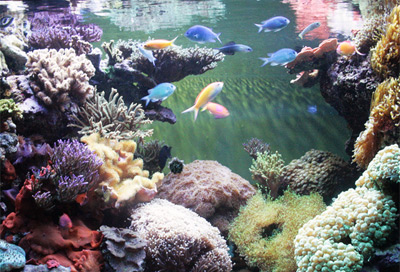Spend any amount of time in this hobby of ours, and you’ll soon realize that the methods and technologies favored for maintaining marine organisms are continually in flux. What’s considered dogma today is heresy tomorrow—and maybe back to dogma again later in the week. (If you doubt me, just ask PaulB! He’s seen more than his share of methodology and technology come and go in his many decades of marine aquarium keeping.)
Here today, gone tomorrow
For the sake of illustration, think how many nitrate-reduction methods have been utilized at one time or another. Jaubert’s plenum method, deep sand beds (DSBs), coil denitration, nitrate-adsorbing filter media, and organic carbon sources coupled with protein skimming are just a sampling of the techniques that have either had their “day in the sun” or are currently in vogue today.
Another example is the use of the wet/dry or trickle-down filter with bioballs for biofiltration. All the rage not that long ago, this technology is now largely considered obsolete (for reefkeeping purposes, anyway) because it tends to do its job too efficiently, earning it the nickname “nitrate factory.”
On the one hand, all this change is exciting because it means we’re ever on the lookout for better, easier, more efficient ways of doing things rather than resting on our collective laurels. On the other hand, the constant evolution of techniques and gadgetry can make it difficult, especially for newer hobbyists, to determine what’s really important and then stay the course until success is achieved.
This trend can also lead to a situation in which even experienced hobbyists are all over the road in their aquarium husbandry—constantly adopting and abandoning techniques rather than following through with one proven-reliable approach.
If it ain’t broke, don’t fix it!
It’s wise to resist the temptation to change course every time the masses seem to be moving in a new direction, for that way lies madness. Heck, I ran a wet/dry biofilter brimming with bioballs on my reef tank long after these systems had fallen into disfavor (admittedly, I’m not what you’d call an “early adopter” when it comes to aquarium technology—or any technology for that matter), but nitrate never became a problem because 1) I tend to stock lightly and 2) I’m fairly conscientious when it comes to water changes.
Focus on tried-and-true techniques
Don’t get me wrong; I’m not disparaging any of the newer technology or methods out there. I just want to convey, particularly to hobby newcomers, that it’s best to focus on tried-and-true husbandry techniques—like routine water changes to dilute nitrate—while you’re getting your feet wet with marine aquarium keeping. Once you’ve mastered the basics, you can always explore other options, provided they make sense for your system and your skill set.
Anyway, it’s time to wrap this up for today. I need to read up on this new Balling method I keep hearing about!



